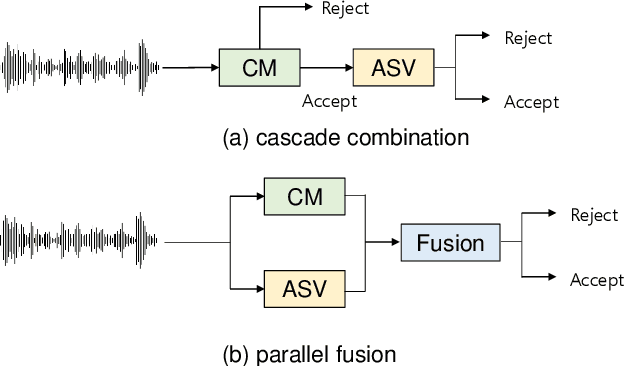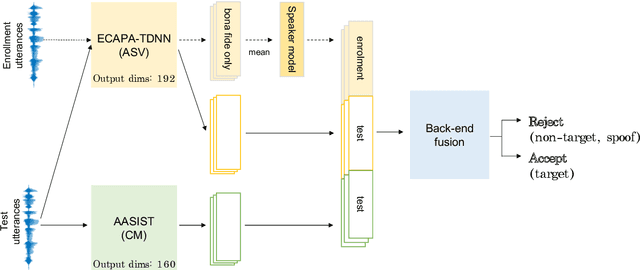Hemlata Tak
ASVspoof 5: Design, Collection and Validation of Resources for Spoofing, Deepfake, and Adversarial Attack Detection Using Crowdsourced Speech
Feb 13, 2025Abstract:ASVspoof 5 is the fifth edition in a series of challenges which promote the study of speech spoofing and deepfake attacks as well as the design of detection solutions. We introduce the ASVspoof 5 database which is generated in crowdsourced fashion from data collected in diverse acoustic conditions (cf. studio-quality data for earlier ASVspoof databases) and from ~2,000 speakers (cf. ~100 earlier). The database contains attacks generated with 32 different algorithms, also crowdsourced, and optimised to varying degrees using new surrogate detection models. Among them are attacks generated with a mix of legacy and contemporary text-to-speech synthesis and voice conversion models, in addition to adversarial attacks which are incorporated for the first time. ASVspoof 5 protocols comprise seven speaker-disjoint partitions. They include two distinct partitions for the training of different sets of attack models, two more for the development and evaluation of surrogate detection models, and then three additional partitions which comprise the ASVspoof 5 training, development and evaluation sets. An auxiliary set of data collected from an additional 30k speakers can also be used to train speaker encoders for the implementation of attack algorithms. Also described herein is an experimental validation of the new ASVspoof 5 database using a set of automatic speaker verification and spoof/deepfake baseline detectors. With the exception of protocols and tools for the generation of spoofed/deepfake speech, the resources described in this paper, already used by participants of the ASVspoof 5 challenge in 2024, are now all freely available to the community.
ASVspoof 5: Crowdsourced Speech Data, Deepfakes, and Adversarial Attacks at Scale
Aug 16, 2024



Abstract:ASVspoof 5 is the fifth edition in a series of challenges that promote the study of speech spoofing and deepfake attacks, and the design of detection solutions. Compared to previous challenges, the ASVspoof 5 database is built from crowdsourced data collected from a vastly greater number of speakers in diverse acoustic conditions. Attacks, also crowdsourced, are generated and tested using surrogate detection models, while adversarial attacks are incorporated for the first time. New metrics support the evaluation of spoofing-robust automatic speaker verification (SASV) as well as stand-alone detection solutions, i.e., countermeasures without ASV. We describe the two challenge tracks, the new database, the evaluation metrics, baselines, and the evaluation platform, and present a summary of the results. Attacks significantly compromise the baseline systems, while submissions bring substantial improvements.
Source Tracing of Audio Deepfake Systems
Jul 10, 2024Abstract:Recent progress in generative AI technology has made audio deepfakes remarkably more realistic. While current research on anti-spoofing systems primarily focuses on assessing whether a given audio sample is fake or genuine, there has been limited attention on discerning the specific techniques to create the audio deepfakes. Algorithms commonly used in audio deepfake generation, like text-to-speech (TTS) and voice conversion (VC), undergo distinct stages including input processing, acoustic modeling, and waveform generation. In this work, we introduce a system designed to classify various spoofing attributes, capturing the distinctive features of individual modules throughout the entire generation pipeline. We evaluate our system on two datasets: the ASVspoof 2019 Logical Access and the Multi-Language Audio Anti-Spoofing Dataset (MLAAD). Results from both experiments demonstrate the robustness of the system to identify the different spoofing attributes of deepfake generation systems.
To what extent can ASV systems naturally defend against spoofing attacks?
Jun 08, 2024Abstract:The current automatic speaker verification (ASV) task involves making binary decisions on two types of trials: target and non-target. However, emerging advancements in speech generation technology pose significant threats to the reliability of ASV systems. This study investigates whether ASV effortlessly acquires robustness against spoofing attacks (i.e., zero-shot capability) by systematically exploring diverse ASV systems and spoofing attacks, ranging from traditional to cutting-edge techniques. Through extensive analyses conducted on eight distinct ASV systems and 29 spoofing attack systems, we demonstrate that the evolution of ASV inherently incorporates defense mechanisms against spoofing attacks. Nevertheless, our findings also underscore that the advancement of spoofing attacks far outpaces that of ASV systems, hence necessitating further research on spoofing-robust ASV methodologies.
Harder or Different? Understanding Generalization of Audio Deepfake Detection
Jun 07, 2024Abstract:Recent research has highlighted a key issue in speech deepfake detection: models trained on one set of deepfakes perform poorly on others. The question arises: is this due to the continuously improving quality of Text-to-Speech (TTS) models, i.e., are newer DeepFakes just 'harder' to detect? Or, is it because deepfakes generated with one model are fundamentally different to those generated using another model? We answer this question by decomposing the performance gap between in-domain and out-of-domain test data into 'hardness' and 'difference' components. Experiments performed using ASVspoof databases indicate that the hardness component is practically negligible, with the performance gap being attributed primarily to the difference component. This has direct implications for real-world deepfake detection, highlighting that merely increasing model capacity, the currently-dominant research trend, may not effectively address the generalization challenge.
t-EER: Parameter-Free Tandem Evaluation of Countermeasures and Biometric Comparators
Sep 21, 2023



Abstract:Presentation attack (spoofing) detection (PAD) typically operates alongside biometric verification to improve reliablity in the face of spoofing attacks. Even though the two sub-systems operate in tandem to solve the single task of reliable biometric verification, they address different detection tasks and are hence typically evaluated separately. Evidence shows that this approach is suboptimal. We introduce a new metric for the joint evaluation of PAD solutions operating in situ with biometric verification. In contrast to the tandem detection cost function proposed recently, the new tandem equal error rate (t-EER) is parameter free. The combination of two classifiers nonetheless leads to a \emph{set} of operating points at which false alarm and miss rates are equal and also dependent upon the prevalence of attacks. We therefore introduce the \emph{concurrent} t-EER, a unique operating point which is invariable to the prevalence of attacks. Using both modality (and even application) agnostic simulated scores, as well as real scores for a voice biometrics application, we demonstrate application of the t-EER to a wide range of biometric system evaluations under attack. The proposed approach is a strong candidate metric for the tandem evaluation of PAD systems and biometric comparators.
Malafide: a novel adversarial convolutive noise attack against deepfake and spoofing detection systems
Jun 13, 2023Abstract:We present Malafide, a universal adversarial attack against automatic speaker verification (ASV) spoofing countermeasures (CMs). By introducing convolutional noise using an optimised linear time-invariant filter, Malafide attacks can be used to compromise CM reliability while preserving other speech attributes such as quality and the speaker's voice. In contrast to other adversarial attacks proposed recently, Malafide filters are optimised independently of the input utterance and duration, are tuned instead to the underlying spoofing attack, and require the optimisation of only a small number of filter coefficients. Even so, they degrade CM performance estimates by an order of magnitude, even in black-box settings, and can also be configured to overcome integrated CM and ASV subsystems. Integrated solutions that use self-supervised learning CMs, however, are more robust, under both black-box and white-box settings.
Towards single integrated spoofing-aware speaker verification embeddings
Jun 01, 2023Abstract:This study aims to develop a single integrated spoofing-aware speaker verification (SASV) embeddings that satisfy two aspects. First, rejecting non-target speakers' input as well as target speakers' spoofed inputs should be addressed. Second, competitive performance should be demonstrated compared to the fusion of automatic speaker verification (ASV) and countermeasure (CM) embeddings, which outperformed single embedding solutions by a large margin in the SASV2022 challenge. We analyze that the inferior performance of single SASV embeddings comes from insufficient amount of training data and distinct nature of ASV and CM tasks. To this end, we propose a novel framework that includes multi-stage training and a combination of loss functions. Copy synthesis, combined with several vocoders, is also exploited to address the lack of spoofed data. Experimental results show dramatic improvements, achieving a SASV-EER of 1.06% on the evaluation protocol of the SASV2022 challenge.
Can spoofing countermeasure and speaker verification systems be jointly optimised?
Mar 31, 2023Abstract:Spoofing countermeasure (CM) and automatic speaker verification (ASV) sub-systems can be used in tandem with a backend classifier as a solution to the spoofing aware speaker verification (SASV) task. The two sub-systems are typically trained independently to solve different tasks. While our previous work demonstrated the potential of joint optimisation, it also showed a tendency to over-fit to speakers and a lack of sub-system complementarity. Using only a modest quantity of auxiliary data collected from new speakers, we show that joint optimisation degrades the performance of separate CM and ASV sub-systems, but that it nonetheless improves complementarity, thereby delivering superior SASV performance. Using standard SASV evaluation data and protocols, joint optimisation reduces the equal error rate by 27\% relative to performance obtained using fixed, independently-optimised sub-systems under like-for-like training conditions.
Baseline Systems for the First Spoofing-Aware Speaker Verification Challenge: Score and Embedding Fusion
Apr 21, 2022



Abstract:Deep learning has brought impressive progress in the study of both automatic speaker verification (ASV) and spoofing countermeasures (CM). Although solutions are mutually dependent, they have typically evolved as standalone sub-systems whereby CM solutions are usually designed for a fixed ASV system. The work reported in this paper aims to gauge the improvements in reliability that can be gained from their closer integration. Results derived using the popular ASVspoof2019 dataset indicate that the equal error rate (EER) of a state-of-the-art ASV system degrades from 1.63% to 23.83% when the evaluation protocol is extended with spoofed trials.%subjected to spoofing attacks. However, even the straightforward integration of ASV and CM systems in the form of score-sum and deep neural network-based fusion strategies reduce the EER to 1.71% and 6.37%, respectively. The new Spoofing-Aware Speaker Verification (SASV) challenge has been formed to encourage greater attention to the integration of ASV and CM systems as well as to provide a means to benchmark different solutions.
 Add to Chrome
Add to Chrome Add to Firefox
Add to Firefox Add to Edge
Add to Edge